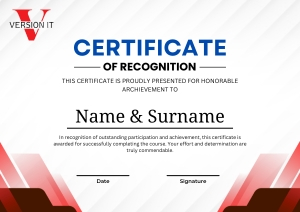Home > Courses > Trending Courses > UNIX Course
UNIX Training in
Hyderabad
We provide comprehensive UNIX training in Hyderabad; you will learn how to handle data, run commands, and transform your programming environment in UNIX. The learner will come out of this session with a solid technical understanding of Unix.
34 Modules
with Certifications
Certificate
After Completion
English
Language
UNIX’s primary characteristics include support for multiple users, multitasking, shell scripting, security, and portability.
Unix is a multitasking, multi-user computer operating system family derived from AT&T Unix. Nowadays, web servers, scientific research, and enterprise-level computers all heavily rely on UNIX. UNIX or its derivatives constitute the foundation of many contemporary operating systems, such as Linux and macOS.
To advance your development abilities, learn how to use the robust Unix command line in Linux, MacOS, and other operating systems. How to utilize the most widely used Unix functions and tools Utilizing Unix shells. well-known command-line editors. Various methods and instructions for working with text files and text output Adding and deleting apps, handling processes, and managing user accounts Helpful commands for troubleshooting online applications and services, as well as network tools
This course aims to equip you with the skills necessary to become a proficient Unix user. By the time this course ends, you will know how to use Unix for standard file management, email, file editing, command pipeline and filtering, file permissions, and modifications. In order to expand your understanding of Unix whenever needed, you will also understand how to obtain online reference materials and support. Get comprehensive coverage of Unix.
What makes Unix so unique? Programmers created the operating system specifically for other programmers. In essence, it’s a massive open development platform. Unix does not try to hide its programming tools from the average user. Developing complex software and testing it on the platform is made simple and enjoyable by the presence of such tools up front. This explains why over the years, Unix has been used to produce a large number of the most widely used programming languages and tools worldwide.
We will cover the fundamentals of this incredible and potent operating system in this course so you can maximize its potential and feel at ease using it to do worthwhile tasks. By the end of this UNIX training, you’ll understand exactly why Unix is so widely used.
Let us guide you in unlocking that power inside yourself in order to elevate your skill set to the next level with this UNIX training in Hyderabad.
Topics You will Learn
Introduction
- Introduction to UNIX/LINUX
- History of UNIX/LINUX
- Features and Benefits of UNIX/LINUX
- Different flavors of UNIX/LINUX
- Difference between UNIX, DOS, Windows and LINUX
- Architecture of UNIX
UNIX File System Architecture
- Boot Block
- Super Block
- Inode Block
- Data Block
File System of UNIX
- Ordinary Files
- Directory Files
- Device Files
- The Structure of UNIX File system
Different UNIX Commands
- pwd, who, whoami
- exit, date, cal, exit, banner
Links
- Hard Link
- Soft link or Symbolic Link
- Unlink
Complex Filters
- tr, comm., tee, sed, nl
Working with Files
- cat, touch, rm
- cp, mv, ln, wc
Working with Directories
- mkdir, cd, rmdir, rm
Displaying Files
- ls, ls with options
Simple Filters
- pg, more, less, head, tail, paste, cut, sort
Zip Files
- gzip, gunzip, zcat, compress
- Uncompress, pack, unpack and Pcat
Printing Files
- lp, cancel
Finding Files
- find, locate etc.,
Input and Output Redirection
- Redirecting Output
- Redirecting Input
- Standard error
Shell Meta Characters
- File substitution
- I/O redirection
- Process Execution
- Quoting meta characters
- Positional parameters
- Special Parameters
More Filters
- grep, grep with options
- fgrep, egrep
Regular Expressions and Patterns
- What is Pattern?
- Usage of regular expression
- Different types of patterns
UNIX Commands
- Uniq
- Diff
- cmp
Backup Utilities
- tar, cpio
Piping
- Usage of piping
- Piping with filters
File Permissions
- chmod, chown, chgrp, umask
Communication Commands
- write, wall, mail, mail with options
Networking commands
- telnet, ftp, rlogin, finger, etc..
Disk Utilities
- df, du, mount, unmount
Job Control
- Foreground jobs
- Background jobs
- Killing jobs
- Nohup
Prcoess Status
- Ps
- Kill
- Pkill
Job scheduling
- At
- Crontab
- Batch
ed, ex and vi editors
- Command mode
- Insert mode
- Ex command mode
Shell Scripting
- What is shell scripting?
- Importance of shell scripting
- Different types of shells
- Creating Shell script
- Making shell script executable
Shell Input and Output
- echo, print, read
Backslash character constants aliases and History concept variables
- What is a variable?
- System defined variables
- Environment Variables
- User defined variables
- Constant variables
- Local and Global variables
- Special Variables
- Comments
Operators
- Arithmetic Operators
- Relational Operators
- Relational ASCII operators
- Logical Operators
- Assignment Operators
Flow Control Structure
- If, if….else
- If… elif
- Case
Flow Control Structure
- while, until, for, break, continue
Let Your Certificates Speak

- Obtain a UNIX certification, such as the Linux Professional Institute Certification (LPIC-1), to demonstrate your proficiency with UNIX-based systems.
- Certificates are globally recognized & they upgrade your programming profile.
- Certificates are generated after the completion of course.
All You Need to Start this Course
- It is necessary to have a basic understanding of command-line operations. Working with UNIX-based systems requires a basic understanding of file manipulation, basic commands, and navigating the UNIX file system.
- It's crucial to know how to handle file and directory permissions in a Unix environment. On Unix-based systems, understanding ownership and notions like read, write, and execute permissions are essential for efficient system administration and security.
Testimonials



Still Having Doubts?
Originally intended to serve multiple users at once, it was a time-sharing system. Because Unix permits direct terminal communication with the computer, it is highly interactive and provides the user with direct control over the computer's resources.
Multiuser and multitasking operating systems are features of UNIX. It is possible for multiple users to be working on different tasks at once. Unlike PC operating systems like MS-DOS or MS Windows, which support multiple users but not multiple tasks at once, this is substantially different.


